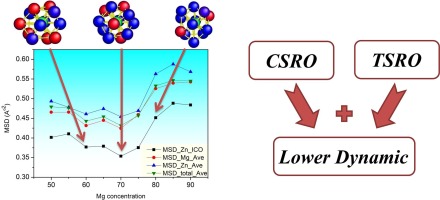当前位置:
X-MOL 学术
›
Comp. Mater. Sci.
›
论文详情
Our official English website, www.x-mol.net, welcomes your
feedback! (Note: you will need to create a separate account there.)
Topological and chemical short-range order and their correlation with glass form ability of Mg-Zn metallic glasses: A molecular dynamics study
Computational Materials Science ( IF 3.1 ) Pub Date : 2020-07-01 , DOI: 10.1016/j.commatsci.2020.109709 A. Foroughi , R. Tavakoli
Computational Materials Science ( IF 3.1 ) Pub Date : 2020-07-01 , DOI: 10.1016/j.commatsci.2020.109709 A. Foroughi , R. Tavakoli

|
Abstract Mg-based metallic glasses are promising materials for biodegradable implants. Understanding atomistic mechanism behind glass formation in these glasses plays a critical role in developing them for future applications. In the present work, we perform a set of molecular dynamics simulations to study structural origin behind glass form ability of Mg-based Mg-Zn metallic glasses at a wide range of compositions. Pair distribution function, Voronoi tessellation and dynamical analysis were adopted to characterize local structures in these glasses. Structural analysis was performed considering both topological and chemical short-range orders. It was found that structure of Mg-Zn metallic glasses could be best described from the perspective of solute-centered clusters. Zn-centered icosahedra, which have the highest symmetry among all local clusters, are preferred in all compositions and its population reaches nearly 28% regardless of the overall chemical composition. The stability of this local cluster depends at high extent to the chemical short-range order around Zn atoms. At favorable composition, that is equivalent to nearly ideal icosahedron geometry, Zn-centered icosahedra would have highest stability and lowest dynamic, which could hinder atoms involved in these clusters from redistribution and/or crystallization. The results offer a good explanation of experimentally observed maximum glass form ability at Mg70Zn30 composition in Mg-Zn system. It could open a door for the engineering of metallic glass alloys compositions for the optimal glass form ability by means of numerical simulations without involving expensive experimental procedures.
中文翻译:

Mg-Zn金属玻璃的拓扑和化学短程有序及其与玻璃形成能力的相关性:分子动力学研究
摘要 镁基金属玻璃是一种很有前途的可生物降解植入材料。了解这些玻璃中玻璃形成背后的原子机制在开发它们以用于未来应用方面起着至关重要的作用。在目前的工作中,我们进行了一组分子动力学模拟,以研究各种成分的 Mg 基 Mg-Zn 金属玻璃的玻璃形成能力背后的结构起源。采用对分布函数、Voronoi 镶嵌和动力学分析来表征这些玻璃中的局部结构。考虑拓扑和化学短程顺序进行结构分析。发现从溶质中心簇的角度可以最好地描述Mg-Zn金属玻璃的结构。以锌为中心的二十面体,在所有局部簇中具有最高对称性,在所有组成中都是首选,无论整体化学组成如何,其种群都达到近 28%。该局部簇的稳定性在很大程度上取决于 Zn 原子周围的化学短程有序。在有利的组成下,即相当于近乎理想的二十面体几何形状,以锌为中心的二十面体将具有最高的稳定性和最低的动态,这可能会阻碍这些簇中涉及的原子重新分布和/或结晶。结果很好地解释了实验观察到的最大玻璃形成能力在 Mg-Zn 系统中的 Mg70Zn30 组成。
更新日期:2020-07-01
中文翻译:

Mg-Zn金属玻璃的拓扑和化学短程有序及其与玻璃形成能力的相关性:分子动力学研究
摘要 镁基金属玻璃是一种很有前途的可生物降解植入材料。了解这些玻璃中玻璃形成背后的原子机制在开发它们以用于未来应用方面起着至关重要的作用。在目前的工作中,我们进行了一组分子动力学模拟,以研究各种成分的 Mg 基 Mg-Zn 金属玻璃的玻璃形成能力背后的结构起源。采用对分布函数、Voronoi 镶嵌和动力学分析来表征这些玻璃中的局部结构。考虑拓扑和化学短程顺序进行结构分析。发现从溶质中心簇的角度可以最好地描述Mg-Zn金属玻璃的结构。以锌为中心的二十面体,在所有局部簇中具有最高对称性,在所有组成中都是首选,无论整体化学组成如何,其种群都达到近 28%。该局部簇的稳定性在很大程度上取决于 Zn 原子周围的化学短程有序。在有利的组成下,即相当于近乎理想的二十面体几何形状,以锌为中心的二十面体将具有最高的稳定性和最低的动态,这可能会阻碍这些簇中涉及的原子重新分布和/或结晶。结果很好地解释了实验观察到的最大玻璃形成能力在 Mg-Zn 系统中的 Mg70Zn30 组成。











































 京公网安备 11010802027423号
京公网安备 11010802027423号